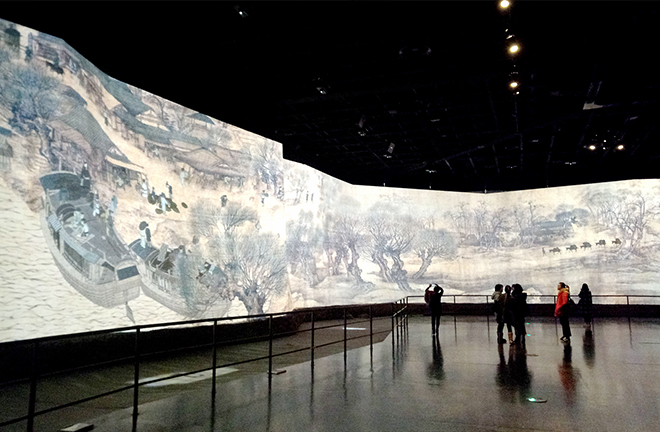Social transition breeds emerging disciplines

A multimedia version of the painting “Along the River During the Qingming Festival” of the 12th century Photo: CFP
The integration of interdisciplinary knowledge has effectively spurred the emergence of new research directions and the development of new disciplines.
Interdisciplinary development
“Traditional disciplinary theories are no longer able to effectively answer and solve some new problems resulting from social development,” said Zhang Qiang, deputy dean of the School of Linguistic Sciences and Arts at Jiangsu Normal University. The knowledge changes brought about by the new technological revolution and the industrial revolution have prompted the reorganization of all disciplines from new perspectives and new technologies. Interdisciplinary development has become an irresistible general trend.
When constructing the disciplinary system, academic system, and discourse system of philosophy and social sciences with Chinese characteristics in the new era, the most vigorous new growth point is contributed by the utilization of modern information technology and big data to tackle problems puzzling the humanities and social sciences. According to Bao Ping, director of the Research Center for Digital Humanities at Nanjing Agricultural University, the application of big data and modern information technology can elevate the freshness, convenience, and efficiency of traditional humanities and historical research. Likewise, the exertion of modern sci-tech in traditional paths of humanities and historical research adds some cultural warmth into the mechanical sense of technical operation.
In Zhang’s view, compared to basic disciplines and traditional disciplines, emerging disciplines encompass new interdisciplinary disciplines formed through the mutual penetration and integration of liberal arts, sciences, and engineering; new iterative disciplines generated by embracing new technologies; and new applied disciplines that meet the needs of economic and social development. In fact, emerging disciplines often have the above three attributes simultaneously, e.g. linguistic research. Current research on language competence, being at the intersection of contemporary linguistics, brain science, cognitive science, artificial intelligence, and other cutting-edge scientific fields, could no longer be handled by traditional linguistics alone but embarks upon a new method of linguistic research.
New disciplinary forms
Some emerging disciplines, after a stage of exploration, accumulation, and sublimation, have begun to move towards a more mature direction. Cognitive neuroscience is an emerging discipline overlapping cognitive psychology and neuroscience, blending knowledge from such fields as physics, engineering, computer science, statistics, cognitive science, psychology, physiology, and neuroscience. It tries to unravel the brain mechanism of cognitive activities from the perspective of “gene-protein-brain-behavior-cognition.”
Zhong Yuan, a professor from the School of Psychology at Nanjing Normal University, has tried for many years to research the brain’s emotional processing circuits and the brain network connectivity of patients with affective disorders such as anxiety disorder, depressive disorder, post-traumatic stress disorder, and adolescent bipolar disorder, adopting multi-modal, multi-omics, and other neuroimaging methods and employing artificial intelligence, machine learning, and deep learning technologies. In doing so, Zhong aims to locate the core target of the occurrence and development of diseases, and decipher the brain science code of diseases, achieving the classification of target diseases as well as individualized prediction, prevention, and treatment. While traditional research in this field, mainly using questionnaire measurements and behavioral observations, lacks enough reliability and validity, emerging disciplines visualize the previously invisible and intangible mental states and have real-time dynamic benefits.
Linguistics is a discipline both old and young, in which recent changes can be described as “earth-shaking.” Modern linguistic research is getting increasingly tied to cutting-edge science as well as economic and social development, Zhang said.
The return of linguistics to the intersection of natural sciences and the humanities has affected the development of neuroscience and artificial intelligence. When riveting on neurolinguistics, a research team from Jiangsu Normal University is also working on brain science and artificial intelligence through the research of the human brain language mechanism. They work to establish the laboratory and disciplinary direction of molecular linguistics, surveying the language mechanism oriented to the next generation of artificial intelligence.
Ecolinguistics, a discipline examining the relationship and the interaction mechanism between language and environment, has quietly emerged in the process of social transition from industrial civilization to ecological civilization.
He Wei, deputy director of the National Research Center for State Language Capacity at Beijing Foreign Studies University, said that in a good momentum of development, ecolinguistics has seen two paradigms—the Haugen Model that inspects the impact of environments on the survival, state, and development of languages, and the Halliday Model that investigates the impact of linguistic usage on environments. Nowadays, more and more young scholars are attracted to the discipline, and strive to continuously broaden the research boundary and transcend the two research modes for a new integrative system.
From the perspective of research objects and scopes, ecolinguistics has stretched its concern from the survival, state, and development of languages to natural environments, and then to social environments. Furthermore, the research purpose of ecolinguistics extends from the harmonious symbiosis between man and nature to that between man and society. In terms of theoretical methods, ecolinguistics is no longer confined to individual theories in systemic functional linguistics, cognitive linguistics, and sociolinguistics, but gradually expands to the entire system of their disciplinary theories, He Wei said.
The use of digital technology and artificial intelligence as tools can strongly drive traditional humanities research, Bao added. As a brand-new interdisciplinary field, digital humanities research is a product of the fast-growing digital technology and interdisciplinary development. Its research paradigm is still under construction, drawing a host of scholars from traditional disciplines.
Edited by YANG LANLAN
